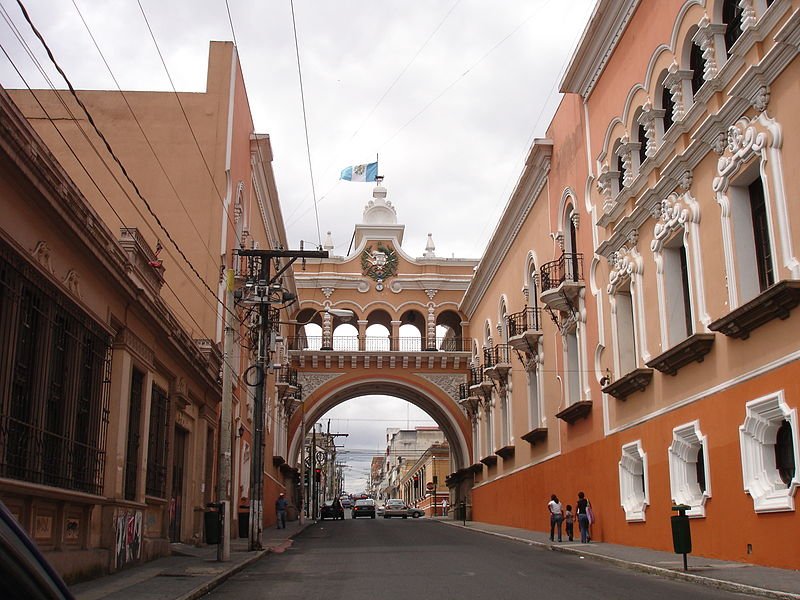 Downtown Guatemala City
Downtown Guatemala CitySource: https://commons.wikimedia.org/wiki/File:ZONAPRADERA.JPG
Author: Shasu

Guatemala City is the biggest city and capital of Guatemala. Its full name is La Nueva Guatemala de la Asunción. Located in the mountain valley of Valle de la Ermita, Guatemala City covers 692 sq km (267.2 sq mi) and has a population of 1.1 million people within a metropolitan area of 3.7 million people.
Guatemala City is 1,500 m (4,921 ft) above sea level. This high altitude has a big impact on its climate. Although it is in the tropics, Guatemala City experiences a climate that can better be described as subtropical highland, with the lowest part of the city experiencing the tropical savanna climate.
On the average, the warmest month in Guatemala City is March, when average high temperature rises to 27.9°C (82.2°F). Coolest month is January, with the average low of 13°C (55.4°F). Guatemala City receives most of its rain between May and September, and hardly any rain between December and February. August is the wettest month, with average total precipitation of a massive 470.8 mm (18.535 in).
 Buildings in Zone 1 of Guatemala City
Buildings in Zone 1 of Guatemala CitySource: https://commons.wikimedia.org/wiki/File:Correos_y_Telecomunicaciones.JPG
Author: Arielaasturias

The history of human habitation in the Guatemala City area goes back to 1,200 BC. Before the modern city came into existence, there was already a Maya city on the same site, called Kaminaljuyu. It was inhabited over a two-thousand-year period beginning in 1,200 BC, but was abandoned in the Late Classic Period of Mesoamerica, which is around AD 600 to 900.
The present city began in 1629 and developed around a monastery known as El Carmen. The country is earthquake prone, and when a massive quake devastated the then capital, Antigua Guatemala, in 1773, King Charles III of Spain decided that the capital of Guatemala be relocated to Guatemala City. This has helped spur its growth ever since.
Visiting Guatemala City
La Aurora International Airport (GUA) is the international gateway to Guatemala. It is located 6.4 km from downtown Guatemala City, which can be reached by taxi. The fare is around US$12. La Aurora receives flights from Atlanta, Dallas/Fort Worth, Chicago, Flores, Fort Lauderdale, Houston, Los Angeles, Madrid, Managua, Mexico City, Miami, Orlando, Panama City, San José de Costa Rica, San Salvador and Tegucigalpa, among others. Metropolitan Cathedral of Guatemala City
Metropolitan Cathedral of Guatemala CitySource: https://commons.wikimedia.org/wiki/File:Guatemala_Cathedral_(3746531166).jpg
Author: Francisco Anzola

Places of Interest in Guatemala City
- Avenida Reforma
A stately boulevard on the east-central part of Guatemala City, considered one of the main thoroughfares of the city. - Centro Cultural Miguel Ángel Asturias
A modern cultural center completed in 1978 and named after Guatemalan writer and Nobel Laurate. - Estadio Nacional Mateo Flores (National Stadium)
The largest multi-use stadium in Guatemala, built in 1948 for the Central American and Caribbean Games of 1950. It was renamed after Mateo Flores, a long-distance runner and winner of the 1952 Boston Maraton. - Kaminaljuyu
The original Mayan city in Guatemala City. Today it is an archaeological site in Zone 11 of the city. - La Aurora Zoo (Parque Zoológico La Aurora)
Zoological park established in 1924 on the southern part of Guatemala City. Over the decades, the expanding international airport has increasingly reduc - Metropolitan Cathedral (Catedral Primada Metropolitana de Santiago)
The main church for Guatemala City as well as the Archdiocese of Guatemala, built between 1782 and 1815. - Museo Nacional de Arqueología y Etnología (National Museum of Archaeology and Ethnology)
This is a national museum dedicated to preserving the archaeological and ethnological heritage of Guatemala, and to research the country's history and cultural heritage. - Museo Popol Vuh
Museum with one of the most significant collections of Mayan artifacts in the world. Opened in 1975, it was named after the book describing Mayan myths and pre-Columbian history of the Quiche people. - National Library of Guatemala (Biblioteca Nacional)
Established in 1879 and operating in its present site since 1957, this is the biggest library in the country. Its interior walls carry a motif of Mayan codices. - National Palace of Culture (Palacio Nacional de la Cultura)
This is the landmark and most imposing building in Guatemala, with all roads radiating from here to the rest of the country. It is also zero-kilometer for all distances from Guatemala City. - Torre del Reformador (Tower of the Reformer)
A 75-meter (246 ft) tower built in 1935 to commemorate the 100th anniversary of the birth of Justo Rufino Barrios, the President of Guatemala in the 19th century. - Zona Viva
A nightlife and entertainment precinct located in Zone 10 of Guatemala City. The area has numerous shopping malls, restaurants and office buildings, and is relatively affluent.
 Latest updates on Penang Travel Tips
Latest updates on Penang Travel Tips

Copyright © 2003-2025 Timothy Tye. All Rights Reserved.

 Go Back
Go Back